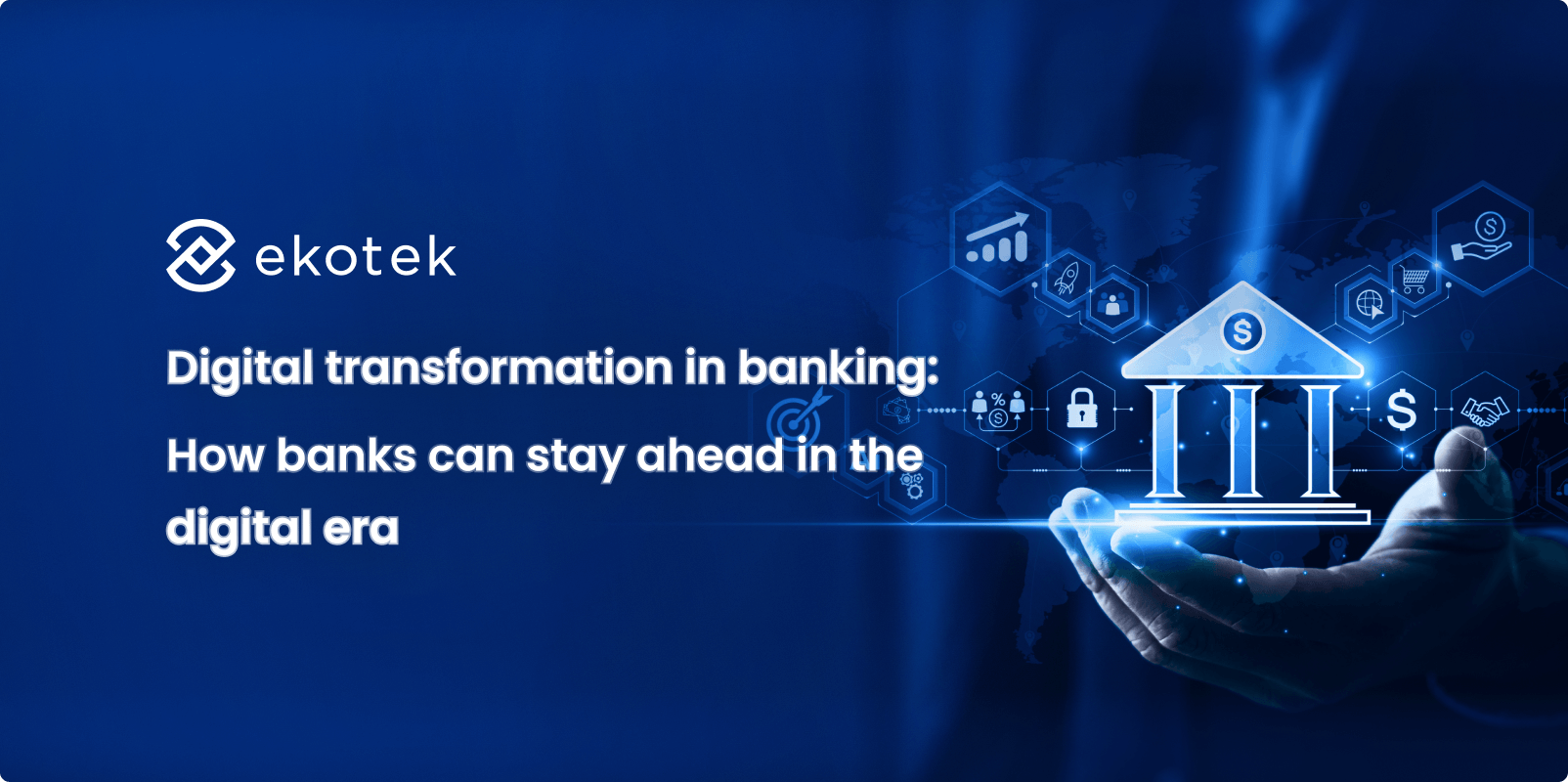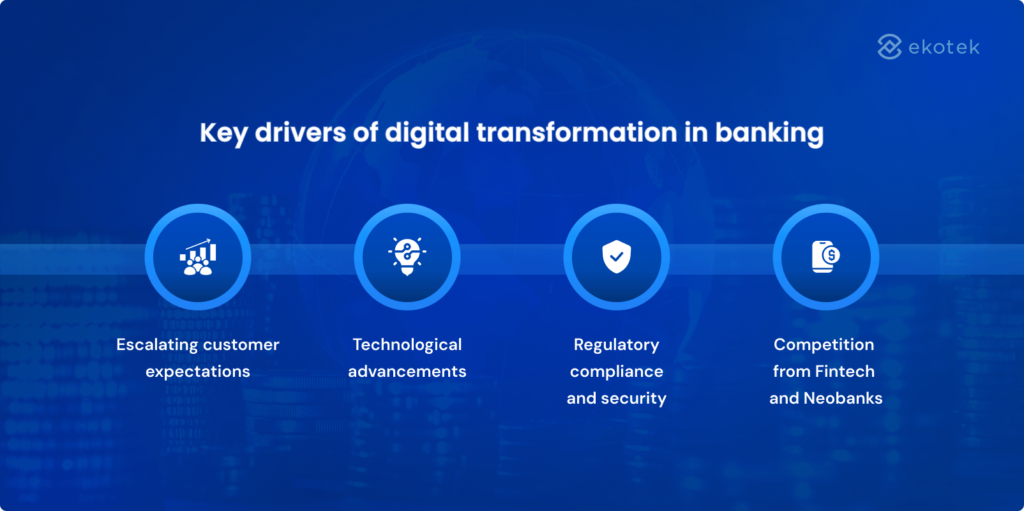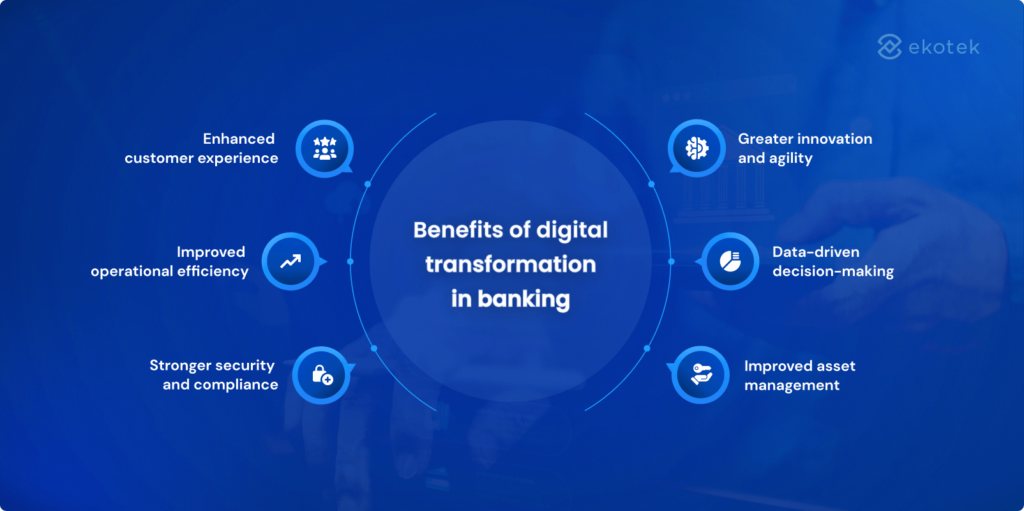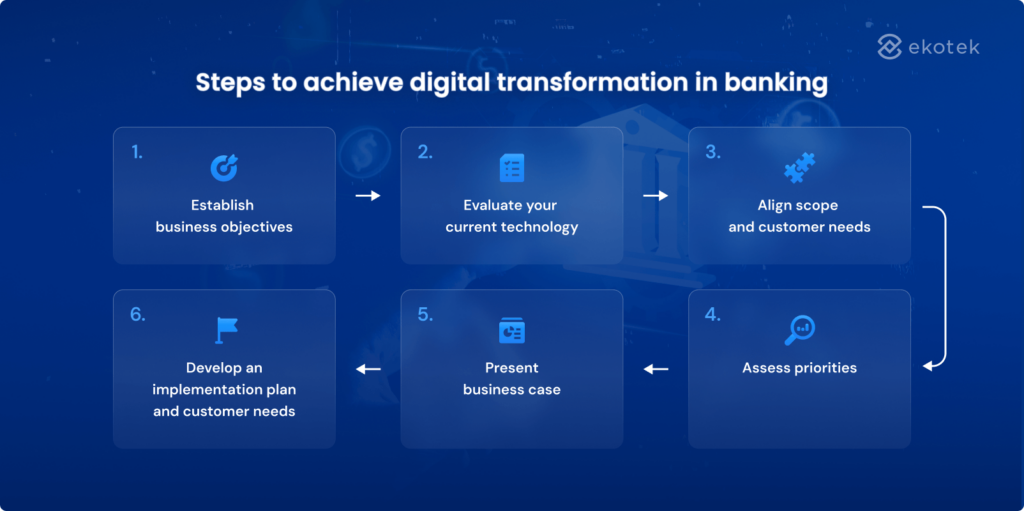
- 1
- 2
- 3
- 4
- 5
- 6
- 7
Introduction
Banking has always been an essential pillar of the global economy, but in today’s digital era, traditional banking models are no longer enough to meet customer demands. Consumers expect instant access to financial services, seamless digital experiences, and heightened security. Meanwhile, fintech companies and neobanks are redefining the industry with innovative, tech-driven solutions. To keep pace, banks must undergo digital transformation – modernizing their operations, adopting advanced technologies, and reshaping their customer engagement strategies.
In this blog, we’ll explore digital transformation in banking benefits, key technologies, and actionable steps for financial institutions looking to future-proof their operations.
What is digital transformation in banking?
Digital transformation in banking refers to integrating advanced technologies to improve banking services. It involves adopting AI, blockchain, automation, and data analytics to modernize financial institutions, making them more agile and competitive in the digital era.
Moreover, digital transformation in banking enables financial institutions to innovate and offer personalized services that anticipate customer needs. By harnessing data analytics, banks can gain valuable insights into customer behaviors and preferences, allowing them to tailor products and services more effectively. Additionally, AI-driven recommendation systems and automation help create seamless, customized banking experiences. Ultimately, digital transformation equips banks to remain competitive in a fast-evolving financial landscape, ensuring they can meet the expectations of digital-savvy consumers while driving growth and efficiency.
Key drivers of digital transformation in banking

Escalating customer expectations
Customers expect not just satisfaction but a seamless and personalized banking experience. For instance, in the financial services sector, 93% of firms have developed advanced digital banking strategies, reflecting a significant shift toward digitalization. These developments have raised the bar for convenience, speed, and responsiveness, leading consumers to expect similar innovations from their banks. Consequently, features like mobile banking, AI-powered chatbots, and self-service portals have become essential rather than optional.
⭐️ Read more: The benefits of AI Chatbots using ChatGPT and a business knowledge base
This shift highlights the need to innovate continuously, as failing to meet these evolving expectations can result in lost customers and diminishing market share. Banking institutions must prioritize understanding their customers’ preferences and behaviors to deliver services that resonate and retain loyalty.
Technological advancements
The rapid advancement of technologies like data analytics and AI is a powerful driver of digital transformation in banking. These technologies streamline operations, reduce manual processes, and enhance fraud detection, making banking services more secure and efficient. For example, AI-powered risk assessment tools enable banks to analyze large datasets in real-time, improving credit scoring accuracy and reducing loan default risks. Additionally, automation in back-office operations minimizes human errors and accelerates transaction processing.
By integrating these technologies, banks can not only enhance security and efficiency but also achieve greater scalability and operational agility, ensuring long-term competitiveness in the financial industry.
Regulatory compliance and security
In an era marked by increasing regulatory scrutiny, banks face the dual challenge of adhering to evolving compliance requirements while ensuring the security of customer assets. Governments and financial regulators continuously update regulations to address concerns such as fraud and money laundering. As a result, traditional banks must invest in advanced security measures and compliance technologies to safeguard their operations and maintain customer trust. This ongoing commitment to security and compliance not only protects customers but also positions banks as reliable and secure institutions in the minds of consumers.
For example, Standard Chartered has been exploring using blockchain technology to combat financial crime. By facilitating secure, real-time information sharing, blockchain can enhance the bank’s efforts in areas like anti-money laundering (AML) and Know Your Customer (KYC) processes, thereby strengthening security and compliance measures.
📌 Dive into the case study: How Ekotek develop an eKYC for real estate platform
Competition from Fintech and Neobanks
These agile competitors leverage technology to provide cost-effective, user-friendly digital banking solutions that appeal to a tech-savvy audience. By offering seamless mobile experiences, lower fees, and innovative services such as instant loans or financial planning tools, these new players are attracting customers away from traditional banks. The pressure is mounting for established financial institutions to modernize swiftly and embrace digital transformation to retain and attract customers. For traditional banks, this means not only upgrading their own technological infrastructure but also fostering a culture of innovation that encourages the development of new services and enhances customer engagement.
Benefits of digital transformation in banking
Digital transformation in banking offers numerous benefits that collectively enhance both customer satisfaction and operational effectiveness.

Enhanced customer experience
Digital banking solutions significantly improve convenience for customers by facilitating faster transactions, seamless digital onboarding processes, and round-the-clock access to banking services. Customers can manage their finances on their own schedule, leading to higher satisfaction levels.
Improved operational efficiency
The implementation of automation reduces the need for manual processes, leading to lower operational costs and increased productivity. Tasks such as document processing and loan approvals can be completed more quickly and accurately through AI-driven automation, allowing employees to focus on higher-value activities.
Stronger security and compliance
In an era of rising cybersecurity threats, digital transformation equips banks with advanced security measures. AI-driven fraud detection systems, biometric authentication, and the transparency afforded by blockchain technology bolster defenses against financial crimes, ensuring customer assets are well protected.
Greater innovation and agility
Cloud-based and API-driven solutions empower financial institutions to respond swiftly to market demands. By facilitating rapid adaptation, these technologies enable banks to introduce new services efficiently and expand their reach to a broader customer base, fostering a culture of continuous innovation.
Data-driven decision-making
Real-time analytics provide valuable insights into customer behaviors and market trends. These insights allow banks to personalize financial products, enhance risk management strategies, and make informed decisions that drive business growth and competitive advantage.
Improved asset management
Digital transformation enhances the ability to track and manage assets effectively. By providing tools for better portfolio performance analysis, banks can minimize risks associated with asset management, ultimately leading to more stable financial outcomes.
Steps to achieve digital transformation in banking

Establish business objectives
The first step in digital transformation is defining clear business objectives that align with the bank’s long-term vision. Financial institutions must identify specific goals, such as improving customer experience, enhancing security, reducing operational costs, or increasing automation. Setting measurable objectives ensures that transformation efforts remain focused and deliver tangible results.
Evaluate your current technology
Banks must assess their existing technology infrastructure to identify gaps and inefficiencies. This includes evaluating core banking systems, cybersecurity frameworks, and data management capabilities. Legacy systems often lack scalability and integration capabilities, making it essential to determine whether to upgrade existing solutions, adopt cloud-based platforms, or invest in new fintech partnerships.
Align scope and customer needs
A successful transformation strategy must be customer-centric. Banks should analyze customer behaviors, preferences, and pain points to ensure that digital solutions address real-world banking challenges. By leveraging data analytics, banks can personalize services, streamline user experiences, and introduce innovative products that meet the evolving needs of customers.
Assess priorities
Since digital transformation is a multi-phase journey, banks need to prioritize initiatives based on their impact, feasibility, and return on investment (ROI). Not all technologies need to be implemented simultaneously, some banks may prioritize AI-powered fraud detection, while others focus on cloud migration. A clear roadmap helps financial institutions implement changes incrementally while minimizing operational disruptions.
Present business case
To gain stakeholder buy-in, banks must develop a compelling business case that outlines the expected benefits, costs, risks, and implementation timelines of digital transformation initiatives. A well-prepared business case should include:
- A clear problem statement and proposed solutions
- Financial projections, including cost savings and revenue growth potential
- Risk assessments and mitigation strategies
- Competitive analysis to highlight industry benchmarks
By effectively presenting the business case, banks can secure funding and executive approval to move forward with their transformation strategy.
Develop an implementation plan
Once approval is secured, banks need to create a detailed implementation plan that addresses potential challenges and ensures a smooth transition. Key considerations include:
- Data migration strategy: Moving from legacy systems to modern infrastructure while ensuring data security and compliance.
- In-house development vs. outsourcing: Banks must decide whether to build digital solutions internally or collaborate with software vendors for faster deployment.
- Integration with existing systems: Ensuring that new technologies seamlessly integrate with core banking platforms to avoid service disruptions.
- Change management & employee training: Preparing staff for new workflows and digital tools through structured training programs.
Success stories of digital transformation in banking
JPMorgan Chase
JPMorgan Chase has been at the forefront of integrating AI to enhance both operational efficiency and customer service. The bank’s strategic AI initiatives have led to significant advancements:
- AI-driven fraud detection: JPMorgan Chase has bolstered its fraud detection capabilities, enabling real-time analysis of transactions to identify and prevent fraudulent activities. This proactive approach has resulted in substantial reductions in fraud-related losses.
- Large Language Models (LLMs) for employee productivity: The bank introduced a suite of LLMs, with over 300,000 employees actively utilizing these tools. In call centers, AI assists agents in swiftly addressing customer inquiries, enhancing both efficiency and accuracy. Additionally, AI aids in legal document analysis, streamlining complex processes and reducing manual workloads.
- Cloud collaboration with AWS: Through a partnership with Amazon Web Services (AWS), JPMorgan Chase leverages AI tools for large-scale data processing, boosting both security and scalability.
BBVA
BBVA has emerged as a leader in adopting generative AI to streamline operations and boost employee efficiency:
- Deployment of digital assistants: The bank has distributed approximately 3,300 AI licenses, leading to the creation of 3,000 digital assistants. These AI-driven tools automate various tasks, such as fraud detection and email management, allowing employees to focus on more strategic activities.
- Employee training and empowerment: BBVA invests in training its workforce to develop and utilize digital assistants, fostering a culture of innovation. This approach not only enhances efficiency but also democratizes access to AI.
HSBC
HSBC has leveraged blockchain technology to enhance cross-border payments, improving transaction speed, security, and transparency. This transformation has been pivotal in modernizing the bank’s international trade financing and remittance services.
- Blockchain-powered settlements: HSBC was one of the first major banks to use blockchain for foreign exchange transactions. Through its FX Everywhere platform, the bank successfully processed over 3 million transactions worth more than $250 billion.
- Trade finance transformation: The bank has partnered with platforms like We.trade and Contour to enable faster and more secure trade finance transactions.
- Digital asset custody and tokenization: HSBC is exploring digital asset custody solutions, allowing institutional clients to securely manage and trade tokenized assets.
Begin your banking transformation journey today
Digital transformation is no longer an option; it’s a necessity for banks to stay competitive. Financial institutions that fail to modernize risk losing market share to fintech companies and digital-first competitors.
Ekotek helps global businesses successfully implement digital transformation across banking, retail, education, and more. We offer DX consulting, product development, and ongoing maintenance, ensuring seamless adoption of advanced technologies. With deep expertise in advanced technologies, a proven track record of success, and the ability to scale rapidly to meet business demands, Ekotek is the trusted partner for financial institutions seeking to future-proof their operations.
- 1
- 2
- 3
- 4
- 5
- 6
- 7